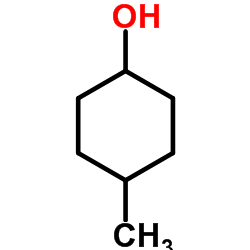4-甲基环己醇

4-甲基环己醇结构式

|
常用名 | 4-甲基环己醇 | 英文名 | 4-Methylcyclohexanol |
|---|---|---|---|---|
| CAS号 | 589-91-3 | 分子量 | 114.186 | |
| 密度 | 0.9±0.1 g/cm3 | 沸点 | 170.3±8.0 °C at 760 mmHg | |
| 分子式 | C7H14O | 熔点 | -41 °C | |
| MSDS | 美版 | 闪点 | 70.0±0.0 °C |
|
Mosquito odorant receptor for DEET and methyl jasmonate.
Proc. Natl. Acad. Sci. U. S. A. 111(46) , 16592-7, (2014) Insect repellents are important prophylactic tools for travelers and populations living in endemic areas of malaria, dengue, encephalitis, and other vector-borne diseases. DEET (N,N-diethyl-3-methylbenzamide) is a 6-decade-old synthetic repellent, which is st... |
|
|
Long-term memory formation in Drosophila requires training-dependent glial transcription.
J. Neurosci. 35(14) , 5557-65, (2015) Long-term memory (LTM) formation requires de novo gene expression in neurons, and subsequent structural and functional modification of synapses. However, the importance of gene expression in glia during this process has not been well studied. In this report, ... |
|
|
Mushroom body output neurons encode valence and guide memory-based action selection in Drosophila.
Elife 3 , e04580, (2014) Animals discriminate stimuli, learn their predictive value and use this knowledge to modify their behavior. In Drosophila, the mushroom body (MB) plays a key role in these processes. Sensory stimuli are sparsely represented by ∼2000 Kenyon cells, which conver... |
|
|
The full-length form of the Drosophila amyloid precursor protein is involved in memory formation.
J. Neurosci. 35(3) , 1043-51, (2015) The APP plays a central role in AD, a pathology that first manifests as a memory decline. Understanding the role of APP in normal cognition is fundamental in understanding the progression of AD, and mammalian studies have pointed to a role of secreted APPα in... |
|
|
Dissecting neural pathways for forgetting in Drosophila olfactory aversive memory.
Proc. Natl. Acad. Sci. U. S. A. 112 , E6663-72, (2015) Recent studies have identified molecular pathways driving forgetting and supported the notion that forgetting is a biologically active process. The circuit mechanisms of forgetting, however, remain largely unknown. Here we report two sets of Drosophila neuron... |
|
|
Aging accelerates memory extinction and impairs memory restoration in Drosophila.
Biochem. Biophys. Res. Commun. 460 , 944-8, (2015) Age-related memory impairment (AMI) is a phenomenon observed from invertebrates to human. Memory extinction is proposed to be an active inhibitory modification of memory, however, whether extinction is affected in aging animals remains to be elucidated. Emplo... |
|
|
Behavioral responses to odorants in drosophila require nervous system expression of the beta integrin gene myospheroid.
Chem. Senses 31(7) , 627-39, (2006) Integrins are cell adhesion molecules that mediate numerous developmental processes in addition to a variety of acute physiological events. Two reports implicate a Drosophila beta integrin, betaPS, in olfactory behavior. To further investigate the role of int... |
|
|
Converging circuits mediate temperature and shock aversive olfactory conditioning in Drosophila.
Curr. Biol. 24(15) , 1712-22, (2014) Drosophila learn to avoid odors that are paired with aversive stimuli. Electric shock is a potent aversive stimulus that acts via dopamine neurons to elicit avoidance of the associated odor. While dopamine signaling has been demonstrated to mediate olfactory ... |
|
|
Studies of 4-methylcyclohexanol: an Aedes triseriatus (Diptera: Culicidae) oviposition attractant.
J. Med. Entomol. 19(5) , 589-92, (1982)
|
|
|
Laboratory tests of the effects of p-cresol and 4-methylcyclohexanol on oviposition by three species of Toxorhynchites mosquitoes.
Med. Vet. Entomol. 3(4) , 347-52, (1989) Laboratory experiments tested the effects of p-cresol or 4-methylcyclohexanol at concentrations of 1, 10 and 50 ppm, on oviposition by the mosquitoes Toxorhynchites brevipalpis Theobald, Tx. amboinensis (Doleschall) and Tx. splendens (Wiedemann). A 5 + 5 ppm ... |